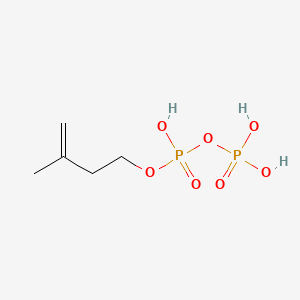| Sabehi G et al. |
New insights into metabolic properties of marine bacteria encoding proteorhodopsins. |
2005 |
PLoS Biol. |
pmid:16008504
|
| Nair SC and Striepen B |
What do human parasites do with a chloroplast anyway? |
2011 |
PLoS Biol. |
pmid:21912515
|
| Yeh E and DeRisi JL |
Chemical rescue of malaria parasites lacking an apicoplast defines organelle function in blood-stage Plasmodium falciparum. |
2011 |
PLoS Biol. |
pmid:21912516
|
| Okada K et al. |
Antisense and chemical suppression of the nonmevalonate pathway affects ent-kaurene biosynthesis in Arabidopsis. |
2002 |
Planta |
pmid:12029484
|
| Nagata N et al. |
Mevalonic acid partially restores chloroplast and etioplast development in Arabidopsis lacking the non-mevalonate pathway. |
2002 |
Planta |
pmid:12447549
|
| Zeidler J and Lichtenthaler HK |
Biosynthesis of 2-methyl-3-buten-2-ol emitted from needles of Pinus ponderosa via the non-mevalonate DOXP/MEP pathway of isoprenoid formation. |
2001 |
Planta |
pmid:11469599
|
| Fraser PD et al. |
Phytoene synthase from tomato (Lycopersicon esculentum) chloroplasts--partial purification and biochemical properties. |
2000 |
Planta |
pmid:10987554
|
| Bajguz A and Asami T |
Effects of brassinazole, an inhibitor of brassinosteroid biosynthesis, on light- and dark-grown Chlorella vulgaris. |
2004 |
Planta |
pmid:14655015
|
| Arimura G et al. |
Herbivore-induced terpenoid emission in Medicago truncatula: concerted action of jasmonate, ethylene and calcium signaling. |
2008 |
Planta |
pmid:17924138
|
| Suzuki N et al. |
Construction and analysis of EST libraries of the trans-polyisoprene producing plant, Eucommia ulmoides Oliver. |
2012 |
Planta |
pmid:22729820
|
| Schwender J et al. |
Chlorophyta exclusively use the 1-deoxyxylulose 5-phosphate/2-C-methylerythritol 4-phosphate pathway for the biosynthesis of isoprenoids. |
2001 |
Planta |
pmid:11289606
|
| Clastre M et al. |
Subcellular evidence for the involvement of peroxisomes in plant isoprenoid biosynthesis. |
2011 |
Plant Signal Behav |
pmid:22080790
|
| Guirimand G et al. |
Triple subcellular targeting of isopentenyl diphosphate isomerases encoded by a single gene. |
2012 |
Plant Signal Behav |
pmid:22951398
|
| Lawo NC et al. |
The volatile metabolome of grapevine roots: first insights into the metabolic response upon phylloxera attack. |
2011 |
Plant Physiol. Biochem. |
pmid:21764593
|
| Arsenault PR et al. |
Reproductive development modulates gene expression and metabolite levels with possible feedback inhibition of artemisinin in Artemisia annua. |
2010 |
Plant Physiol. |
pmid:20724645
|
| Yasuor H et al. |
Differential oxidative metabolism and 5-ketoclomazone accumulation are involved in Echinochloa phyllopogon resistance to clomazone. |
2010 |
Plant Physiol. |
pmid:20207709
|
| Vallabhaneni R and Wurtzel ET |
Timing and biosynthetic potential for carotenoid accumulation in genetically diverse germplasm of maize. |
2009 |
Plant Physiol. |
pmid:19346441
|
| Oba K et al. |
Induction of Furano-terpene Production and Formation of the Enzyme System from Mevalonate to Isopentenyl Pyrophosphate in Sweet Potato Root Tissue Injured by Ceratocystis fimbriata and by Toxic Chemicals. |
1976 |
Plant Physiol. |
pmid:16659619
|
| Lange BM et al. |
Isoprenoid biosynthesis. Metabolite profiling of peppermint oil gland secretory cells and application to herbicide target analysis. |
2001 |
Plant Physiol. |
pmid:11553758
|
| Post J et al. |
Laticifer-specific cis-prenyltransferase silencing affects the rubber, triterpene, and inulin content of Taraxacum brevicorniculatum. |
2012 |
Plant Physiol. |
pmid:22238421
|
